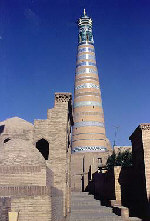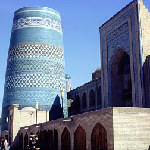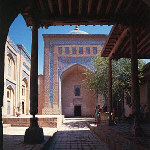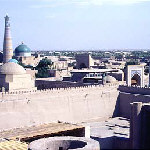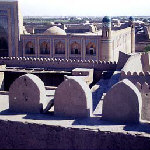|
Khorezm has a very long history, only a few civilizations could be compared with it. Hundred years before the Great Silk Road appeared, ancient Khorezm had had links with Europe and the East, with Siberia and southern civilizations. It is a cradle of three civilizations formed in Uzbekistan. The Khorezm Khanate was very famous in the fourth
century, BC. It was very powerful state. Fairy-tale like city Khiva
has managed to retain its exotic image of an Oriental town in the
older part of the city called Ichon-Qala. Ichon-Qala is a place
where all the monuments of architecture are located. Among them
there are the Kunya-Ark citadel and the Tosh-Khovli Palace, residence
of the Khan, which had been preserved intact along with its ornate
gates. Besides, Ichon-Qala displays simplicity and monumentality
of medieval architectural forms, the delicateness of woodcarvings,
and skilled interweaving of ornamentation. The silhouettes of its
towering minarets, hemmed in by clay built houses with their flat
roofs and surrounded by the fortress's powerful clay built walls,
give a clear idea of a typical Central Asian feudal city. A respected patron saint of Khiva, Khiva pir Pakhlavan Makhmud (1247-1325) was a furrier, he made fur-coats and was famous by his athletic strength well known far beyond the borders of Khiva Khanate. Pakhlavan Makhmud stayed in memory of generations as a great poet and sage, proclaimed a Muslim Saint, as he belonged to Kungrad Dynasty. In the 19th c. Khiva Khans made him a Saint Patron of Kungrad Dynasty. Pakhlavan Makhmud's tomb was rebuilt in the 19th century and then requisitioned in 1913 by the khan of the day as the family mausoleum. Islam Khoja was Asandiar Khan's grand vizier and father-in-law. Visits to St. Petersburg and Paris filled his mind with the wonders of technology. He built a cotton mill, a hospital and Khiva's first Khoja minaret, narrow at the top, lantern-shaped and crowned with a small cupola, and linked the city with the outside world by telegraph. The majestic 45 meter Islam Khoja minaret can be seen from everywhere in the city. It has 118 steps and views right to the desert. An old castle, citadel Kunya Ark sides with the western
wall of Ichon-Qala. This castle was a center around which the city
of last Khiva Khans developed. The decoration of ayvans on the kurynyshkhana
and mosque is wonderful, with the walls covered with glazed tile
and columns and doors with delicate woodcarving. |
|

